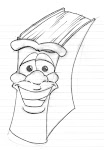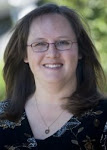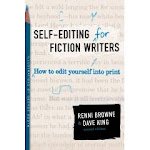 Anita (and others), I apologize for the delayed response to the latest submission. I simply got swamped, and because of that, I'll be involving more editors to keep the blog moving. Thank you (especially Anita) for your patience.
Anita (and others), I apologize for the delayed response to the latest submission. I simply got swamped, and because of that, I'll be involving more editors to keep the blog moving. Thank you (especially Anita) for your patience.Since we're talking about children's fiction, and the author is clearly British, please keep in mind, the rules for British children's books may vary from American rules. The American books regarding children's fiction are located on the left sidebar; however, Anita, since you're in the UK, you might more easily get your hands on a British title: Writing for Children and Getting Published by Allan Frewin Jones and Lesley Pollinger. In my opinion this doesn't cover as much ground as Tracy E. Dils' book You Can Write Children's Books, which is American. Another helpful book is Alijandra Mogilner's Children's Writer's Word Book which is a handy thesaurus and lists the appropriate age group for each word. Yes, another American book.

Folks, the general population believes that writing for children is much easier than writing for adults. I beg to differ. There are many aspects in children's fiction that do not apply to adult fiction. In adult fiction, we don't have to worry about whether or not a word might be too difficult to understand for the reader, and sentences may be as long as we wish. With children's fiction, there are strict guidelines regarding sentence length and vocabulary. As far as picture books are concerned, that's a whole different story. No "pun" intended. With picture books, the illustrations tell as much of the story as the text. Finding the right balance isn't easy.
Now to begin: Because of the length, I assumed this was a picture book text. However, based on what Anita shared in the comments (this being for the 6-10 year age group), that would mean, this is actually a chapter book. (Well done, Victoria!)
What is a chapter book?
A chapter book bridges the gap between picture books and novels.
They have fewer illustrations than picture books and some may not have any illustrations at all. So Anita, your wonderful descriptions may stay.
Chapter books may vary in length, anywhere from 1500 to 15,000 words.
They have one main character who has a problem and that character needs to find a solution to his or her problem, overcoming obstacles on the way. (Not much unlike a novel.)
Chapter books also have shorter sentences than what you'd find in a middle reader or novel. Sentence length should be no longer than 10-15 words. If you go over this, it's not the end of the world; however, I would definitely make an effort to shorten the sentences in the piece below. Most of them are too long.
Difficult (and foreign) words should be defined in the text. Anita, I didn’t find any words that I felt were unsuitable for a chapter book. Still, I'll provide an example of how a word can be defined in the text by using its context (the following is taken from my novel; take note that the same rule can be applied in adult fiction): Titus ordered David to stand in the center of the room next to the impluvium. David ran his hand along the smooth edge of the large marble fountain that collected rainwater from an opening in the roof. Here we learn that an "impluvium" is a "fountain" without "telling" the reader or having to set up a "dictionary" in our book (one of my pet-peeves in fiction). A reader should not have to stop mid-story to look up an unfamiliar or foreign word. The story continues to unfold without stopping the action.
It was mentioned that this is one story in a series. Series books tend to be for "middle readers" which is just a step above chapter books. However, since this is one story, you can probably combine all of them, creating one book. Remember, they can be as long as 15,000 words, so "The Beach" would be one chapter. Keep in mind, each publisher will have their own specific guidelines for length.
Anita, your writing is excellent. The only thing to avoid are the "telling" words, such as "warned." A person can't "warn" a statement. I'm sure you're tired of hearing me say this, but I have to so others can learn. See explanation of "attributions" below. And we all know, rules are meant to be broken.
I didn't edit the manuscript for a number of reasons:
The writing is excellent, and I dare not touch it to shorten the sentences for fear I'll intrude on Anita's voice. She has to do that herself. Most of the sentences need to be shortened, and by my attempting to do that, the rhythm will change, not to mention the vocabulary that Anita would likely choose. This particular rhythm and vocabular is uniquely Anita's and can't be immitated. It defines her voice.
There's also too much introspection for a chapter book. Kids need stories with "movement." In other words, we need a lot of action and dialogue.
The ending should be the beginning; therefore, I suggest a complete rewrite, starting the story at the end when Rhy's discovers the first of the Sandelves. The ending of the story is excellent. It was my favourite part. Problem is, it's your "hook" and should be in the opening paragraphs.
The story needs a "plot" as Janet suggested. Each chapter should have a beginning, middle and an end. Establish Rhys' goal and create the conflict. You've done well to do that by having Mum interrupt his discovery. Another reason that part needs to open the story.
Anita, I love the idea of Sandelves! I realize, suggesting that you revamp this entire submission is a bit daunting, but I believe you're onto something unique and fun for children.
Whatever you do, don't give up on these stories!












No comments:
Post a Comment